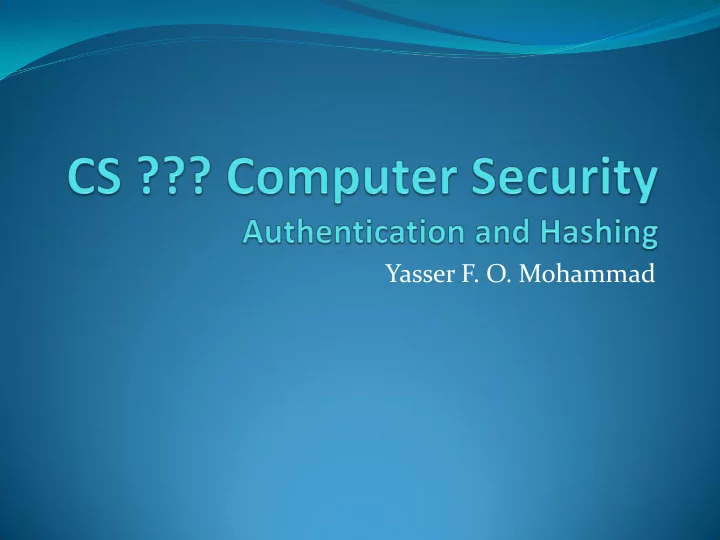

Yasser F. O. Mohammad
REMINDER 1:Fiestel Network Each round consists of: Substitution on left half of text Permutation of the two halves The substitution is controlled by the key of every round Factors of Security: Block size Key size N. rounds Subkey generation Round Function Decryption = Encryption with reversed subkey order
REMINDER 2: CBC ( Cipher Block Chaining Mode )
REMINDER 3: CTR (Counter Mode)
REMINDER 4: Key Hierarchy
REMINDER 5: Key Distribution Center
Rule of Authentication Encryption protects against passive attacks Authentication protects against active attacks Authentication uses encryption
Different Uses of Encryption
Authentication Without Confidentiality Why? Broadcasting I am too busy to encrypt Authentication of programs (no need to decrypt every time) How? Message Authentication Code (MAC) One Way Hash function
MAC A B : M MAC MAC Substring E k , M , n A B B : M Substring M , strlen M n 1 received received , , Test MAC Substring E k M n A B 1 B knows that the message was not altered. Why? B knows that the message is from A. Why? If the message contains a sequence number, B knows that the order was not altered Usually DES is used and n equals 16 or 32
Authentication using shared key A B M : E k ,' hello ' M 1 A B B :if Substring D k , M ,5 ' hello ' then A B 1 received M M 1 received 1 Sender M A 1 if E A then cannot read E M How can we use this exchange to agree on a new key? Why would we want to do that?
One Way Hash Functions Only we know k a) Most conventional Uses Public Keys only b) Offers Nonrepudiation No key distribution Only we know the secret c) No encryption Used in HMAC adopted by IP security Why No Encryption? Encryption is slow 1. Encryption is expensive 2. Encryption is optimized for large 3. Patents & export control 4.
Hash function Requirements Arbitrary Data Size Fixed length output Easy to compute One Way: Given the hash we should not recover the message Weak collision resistance: given x we cannot find y so that H(x)=H(y) Strong collision resistance: we cannot find any (x,y) so that H(x)=H(y)
General Hashing algorithm n bits hash Treat the message as a sequence of n bit blocks Process each block in some order Output the final n bits
Simplest hash function (XOR) How to break this?
First Improvement (RXOR) How to break this?
Modern Hash Functions SHA-1 (self read the algorithm) Maximum input is 2 64 Digest size = 160 bits Block size is 512 or 1024 bits
Other Hash functions MD5 By Ron Rivest 128 bit digest 512 bit blocks Arbitrary input length RIPMOD 160 160 bit digest 512 bit block
HMAC A hash function that uses a key but does not require slow encryption.
Recommend
More recommend